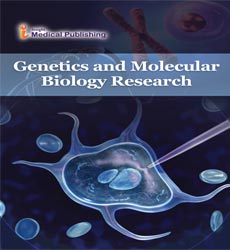Interaction of a Begomovirus with the Opioid Biosynthetic Pathway of Opium Poppy
Amity Institute of Virology and Immunology, Amity University, Noida, India
- *Corresponding Author:
- Ashish Srivastava
Amity Institute of Virology and Immunology
Amity University, Noida, India
Tel: +91-9696696287
Email: ash12biotech@gmail.com
Received date: October 15, 2018; Accepted date: October 17, 2018; Published date: October 24, 2018
Citation: Srivastava A (2018). Interaction of a Begomovirus with the Opioid Biosynthetic Pathway of Opium Poppy Genet Mol Biol Res Vol No: 2 Iss No: 2:8
Copyright: © 2018 Srivastava A. This is an open-access article distributed under the terms of the Creative Commons Attribution License, which permits unrestricted use, distribution, and reproduction in any medium, provided the original author and source are credited.
Abstract
Opium poppy (Papaver somniferum) is a herbaceous plant of the family Papaveraceae grown for its medicinally important alkaloids. It was regarded as a magic plant in the classical period of ancient Greece. The major constituents of opium are phenanthrenes: morphine (about 12% w/w), codeine (about 0.5% w/w) and thebaine (about 0.2% w/w), and benzylisoquinoline: noscapine (about 6% w/w) and papaverine (about 1% w/w).
Editorial
Opium poppy (Papaver somniferum) is a herbaceous plant of the family Papaveraceae grown for its medicinally important alkaloids. It was regarded as a magic plant in the classical period of ancient Greece. The major constituents of opium are phenanthrenes: morphine (about 12% w/w), codeine (about 0.5% w/w) and thebaine (about 0.2% w/w), and benzylisoquinoline: noscapine (about 6% w/w) and papaverine (about 1% w/w) [1]. Morphine is a narcotic analgesic medication used for the severe pain and has effects in the central nervous system and on smooth muscle. While the noscapine is a nonsedative, antitussive drug and recently its anti-mitotic activity was identified which may be used in cancer treatment [2]. Recently Prof. Graham and his team have decoded the whole genome of opium poppy which enabled the identification of a large cluster of 15 genes that encode enzymes for biosynthesis of essential opium alkaloids [3].
Viral diseases are a key constraint in the production of opium poppy crops in developing countries. Several viral diseases caused extensive damage to opium poppy. In India, opium poppy crops were found to be threatened by a severe mosaic disease, caused by Poppy Mosaic Virus (PMV-P) of family Potyviridae [4]. Srivastava et al. [5],Srivastava et al. [6] have reported a previously unknown disease of opium poppy which causes severe vein thickening and inward leaf curl in the plants. The whitefly-transmitted begomoviruses, Tomato Leaf Curl New Delhi Virus (TLCNDV) and Ageratum Enation Virus (AEV) were found to be associated with the disease which may put opium poppy production in jeopardy in India and worldwide. The comprehensive histological, biochemical, and metabolomic investigations of virus-infected poppy plants and healthy plants by [5] revealed severe alteration at structural and metabolomic level. Virus-infection altered the biosynthesis of several important metabolites. The induced Programmed Cell Death (PCD) was also observed in virus-infected opium poppy plants by Comet assay and TUNEL and Hoechst dye staining assays.
The analysis of alkaloid contents in AEV infected plants in comparison to healthy plants exposed a surprising observation. The AEV infection tends to downregulate the biosynthesis of morphine, thebaine, codeine, and papaverine alkaloids while the biosynthesis of the PCD inducing anticancer alkaloid noscapine was marginally upregulated. The expressions of the genes of the biosynthetic pathway in AEV infected opium poppy were also corroborated with these findings. The reasons for the upregulation of noscapine biosynthesis is unknown, however, [7,8] compared three traits of poppy in HM1, HT1, and HN1 lines synthesizing morphine, thebaine, and noscapine, respectively, in large quantities, and showed that when noscapine is high in capsule, the morphine is low, presumably due to the substrate competition and showed the accumulation of noscapine pathway intermediates in transiently silenced HM1 plants. The overall research evidenced the existence of complicated defense and counter-defense strategies during opium poppy and AEV interaction. Further research is focused on the detailed transcriptomic expression studies will to understand the molecular basis of defense and counter-defense strategies of opium poppy and begomovirus.
References
- https://cbn.nic.in/html/opiumcbn.htm
- Mahmoudian M, Rahimi-Moghaddam P (2009) The Anti-cancer activity of noscapine: a review.Recent Pat Anticancer Drug Discov 4:92-97.
- Guo L, Winzer T, Yang X, Li Y, Ning Z, et al. (2018) The opium poppy genome and morphinan production. Science.
- Zaim M, Verma RK, Pandey R, Lal RK (2014) Genotype-dependent response of an RNA virus infection on selected pharmaceutically important alkaloids in Papaver somniferum. J Herbs Spices Med Plants 20: 124-131.
- Srivastava A, Agrawal L, Raj R, Jaidi M, Raj SK, et al. (2017) Ageratum enation virus infection induces programmed cell death and alters metabolite biosynthesis in Papaver somniferum. Front plant sci 1172: 1-15.
- Srivastava A, Kumar S, Jaidi M, Raj SK, Shukla SK (2015) First report of Tomato leaf curl New Delhi virus on opium poppy (Papaver somniferum) in India. Plant Disease 100: 232.
- Winzer T, Gazda V, He Z, Kaminski F, Kern M, et al. (2012) A Papaver somniferum 10-gene cluster for synthesis of the anticancer alkaloid noscapine. Science 336: 1704-1708.
- Mahmoudian M, Rahimi-Moghaddam P (2009) The Anti-Cancer Activity of Noscapine: A Review .Recent Pat Anticancer Drug Discov 4: 92-97.
Open Access Journals
- Aquaculture & Veterinary Science
- Chemistry & Chemical Sciences
- Clinical Sciences
- Engineering
- General Science
- Genetics & Molecular Biology
- Health Care & Nursing
- Immunology & Microbiology
- Materials Science
- Mathematics & Physics
- Medical Sciences
- Neurology & Psychiatry
- Oncology & Cancer Science
- Pharmaceutical Sciences
